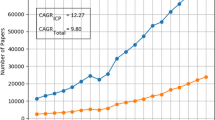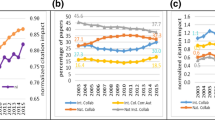Abstract
This bibliometric study on the collaboration of Austria and six target countries (Slovenia, Hungary, Czech Republic, Denmark, Switzerland and Israel) reveals the importance of differentiation between the bilateral and multilateral contingents in the assessment of international scientific collaboration. For this purpose a “degree of bilaterality” (DB) and a “citation degree of bilaterality” (CDB) are introduced. In our findings the DB and the CDB have values lower than 1/3 and 1/5, respectively. Therefore, the total collaboration is mostly shaped in its volume and impact by the multilateral contingent. Regarding the impact estimation of the collaboration publication output, a multi-faceted approach was used. It is recommended to separately analyze the following three aspects: the un-cited range, the average range and the excellence range. Considering different country specific parameters the total number of publications and citations were resized for each type of collaboration and the results discussed. Only a very weak correlation between ‘times cited’ and the number of affiliations or authors was observed at publication level. Neither the number of authors or affiliations determines impact increase. Rather internationalisation and cooperation seem to be the crucial factors.













Similar content being viewed by others
References
Adams, J., Gurney, K. A., & Marshall S. (2007a). Patterns of international collaboration for the UK and leading partners (Summary report). A report commissioned by the UK Office of Science and Innovation (http://www.berr.gov.uk/files/file40396.pdf).
Adams, J., Gurney, K. A., & Marshall, S. (2007b). Profiling citation impact: A new methodology. Scientometrics, 72(2), 325–344.
Beaver, D. D. (2001). Reflections on scientific collaboration, (and its study): Past, present, and future. Scientometrics, 52(3), 365–377.
Bordons, M., Gómez, I., Fernández, M. T., Zulueta, M. A., & Mendez, A. (1996). Local, domestic and international scientific collaboration in biomedical research. Scientometrics, 37(2), 279–295.
Chinchilla-Rodríguez, Z., Miguel, S., Benavent-Pérez, M., & Moya-Anegon, F. (2011). International scientific collaboration between Latin American countries in Medicine. REDC, in press.
Glänzel, W. (2001). National characteristics in international scientific co-authorship. Scientometrics, 51(1), 69–115.
Glänzel, W., & Schubert, A. (2001). Double effort = double impact? A critical view at international co-authorship in chemistry. Scientometrics, 50(2), 199–214.
Glänzel, W., Schubert, A., & Czerwon, H. J. (1999). A bibliometric analysis of international scientific cooperation of the European Union (1985–1995). Scientometrics, 45(2), 185–202.
Gomez, I., Fernandez, M. T., & Sebastian, J. (1999). Analysis of the structure of international scientific cooperation networks through bibliometric indicators. Scientometrics, 44(3), 441–457.
Gorraiz, J., Reimann, R., & Gumpenberger, C. (2011), The importance of bilateral and multilateral differentiation in the assessment of international collaboration—A case study for Austria and six countries. In E. Noyons, P. Ngulube, & J. Leta (Eds.), Proceedings of ISSI 2011—The 13th international conference on scientometrics and informetrics, Durban, South Africa, 4–7 July 2011, pp. 236–248.
Hsiang Liao, C. (2011). How to improve research quality? Examining the impacts of collaboration intensity and member diversity in collaboration networks. Scientometrics, 86(3), 747–761. doi:10.1007/s11192-010-0309-2.
Hsu, J., & Huang, D. (2011). Correlation between impact and collaboration. Scientometrics, 86(2), 317–324. doi:10.1007/s11192-010-0265-x.
Key figures. (2007). Towards a European research area: Science, technology and innovation/European Commission, Directorate-General for Research (2007); Luxembourg: Office for Official Publications of the European Communities. ISBN 9789279034503 9279034502, http://cordis.europa.eu/documents/documentlibrary/97946551EN6.pdf.
Lee, K., Brownstein, J. S., Mills, R. G., & Kohane, I. S. (2010). Does collocation inform the impact of collaboration? PLoS ONE, 5(12), e14279. http://www.plosone.org/article/info%3Adoi%2F10.1371%2Fjournal.pone.0014279.
Luukkonen, T., Persson, O., & Sivertsen, G. (1992). Understanding patterns of international scientific collaboration. Science, Technology and Human Values, 17, 101–126.
Luukkonen, T., Tijssen, R. J. W., Persson, O., & Sivertsen, G. (1993). The measurement of international scientific collaboration. Scientometrics, 28(1), 15–36.
Moed, H. F. (2010). CWTS crown indicator measures citation impact of a research group’s publication oeuvre. Journal of informetrics, 4(3), 436–438.
Persson, O. (2010). Are highly cited papers more international? Scientometrics, 83(2), 397–401.
Persson, O., Glänzel, W., & Danell, R. (2004). Inflationary bibliometric values: The role of scientific collaboration and the need for relative indicators in evaluative studies. Scientometrics, 60(3), 421–432.
Reckling, F. (2007). A contest between nations; or how far is Austrian research behind that of the world leaders? An analysis on the competitiveness of Austria’s scientific research in the natural and social sciences. Vienna: FWF. Accessed October 2007, from http://www.fwf.ac.at/de/downloads/pdf/contest_between_nations.pdf.
Roberts, G. (2006). International partnerships of research excellence: UK–USA academic collaboration. University of Oxford, http://www.wolfson.ox.ac.uk/archive/uk-us-academic-collaboration/GarethRobertsIPoREx.pdf.
Van Leeuwen, T. N., & Tijssen, R. J. W. (2007). Strength and weakness of national science systems. A bibliometric analysis through cooperation patterns. Scientometrics, 79(2), 389–408.
Acknowledgments
This study is the by-product of a data analysis performed in cooperation with and supported by the Austrian Science Fund (FWF). The authors thank Ambros Wernisch and Steve Reding for their support with compiling the data, and Prof. Christoph Kratky and Dr. Falk Reckling for their interesting suggestions.
An extended version of a paper presented at the 13th International Conference on Scientometrics and Informetrics, Durban (South Africa), 4–7 July 2011 (Gorraiz et al. 2011).
Author information
Authors and Affiliations
Corresponding author
Rights and permissions
About this article
Cite this article
Gorraiz, J., Reimann, R. & Gumpenberger, C. Key factors and considerations in the assessment of international collaboration: a case study for Austria and six countries. Scientometrics 91, 417–433 (2012). https://doi.org/10.1007/s11192-011-0579-3
Received:
Published:
Issue Date:
DOI: https://doi.org/10.1007/s11192-011-0579-3




